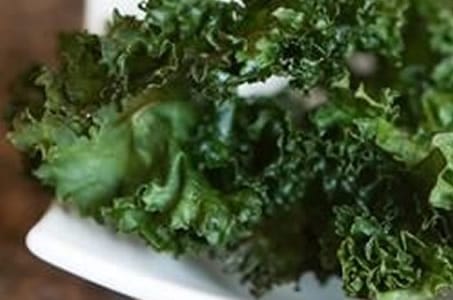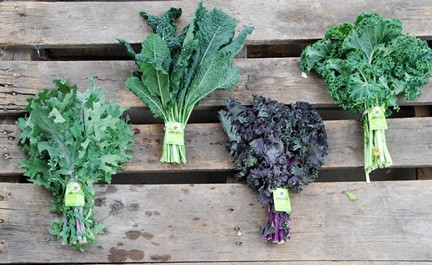Seems I’m always chanting “eat your dark leafy greens!” A lot of people may think lettuce qualifies here but it really doesn’t. I’m talking deep, dark green stuff like Swiss chard, collards, and KALE. If you haven’t yet added kale to your diet this might just convince you. Of all the super healthy greens, kale is king! It may be one of the most nutrient dense foods on the planet. With several varieties and recipes galore on the internet, there’s no reason to avoid it any longer.
Kale is part of the cabbage or “Brassica” family of vegetables, it’s related to cruciferous vegetables like broccoli, cabbage, cauliflower, collard greens and Brussels sprouts. The leaves can be green or purple in color; smooth or curly in shape. A singe cup of kale contains more than the recommended daily allowance of vitamins A and K, it also contains Vitamin C, manganese, calcium, copper, potassium, magnesium, B1, B2, B3, B6, folate, iron and phosphorus – that’s quite a punch – all inside 33 calories, 6 grams of carbs (2 of which are fiber) and 3 grams of protein.
Alongside all these vitamins and minerals, kale is chalk full of antioxidants that help counteract oxidative damage in the body – believed to be a leading force in aging and many diseases including cancer. It also contains compounds like sulforaphane and indole-3-carbinol that are cancer protective.
Kale supports eye health. Most people know beta carotene (which converts to vitamin A) is good for the eyes but in addition to this, kale also has lutein and zeaxanthin, both of which are protective against macular degeneration and cataracts.
Are you methylating? Methylation is a key biochemical process that is essential for the proper function of almost all of your body’s systems. It occurs billions of times every second; it helps repair your DNA on a daily basis; it controls homocysteine (an unhealthy compound that can damage blood vessels); it helps recycle molecules needed for detoxification; and it helps maintain mood and keep inflammation in check. Kale contains ample B vitamins and other nutrients needed for this critical process.
Another advantage over other leafy greens like spinach is that it’s low in oxalates – a substance in some plants that can prevent mineral absorption.
So, how do you go about incorporating this phenomenal vegetable into your diet? Here are two very simple but delicious recipes! Grab a bunch of kale next time you shop and give one of these a try.

Kale Chips
Ingredients
- 1 bunch Kale (I like the curly type for this)
- 1 tsp. olive oil or avocado oil
- 1 pinch sea salt or Herbamare (my favorite seasoning blend found at natural grocery stores)
Instructions
- Preheat oven to 325 degrees F. Wash and de-stem one bunch of kale. Break into “chip” size pieces and massage about a teaspoon of olive oil or avocado oil into the kale pieces. Spread out on a baking tray and sprinkle with sea salt. Bake at low heat, about 325 degrees for about 15-20 minutes. Watch carefully at the end so they don’t overcook, you just want them to be dry and crunch, not brown.


